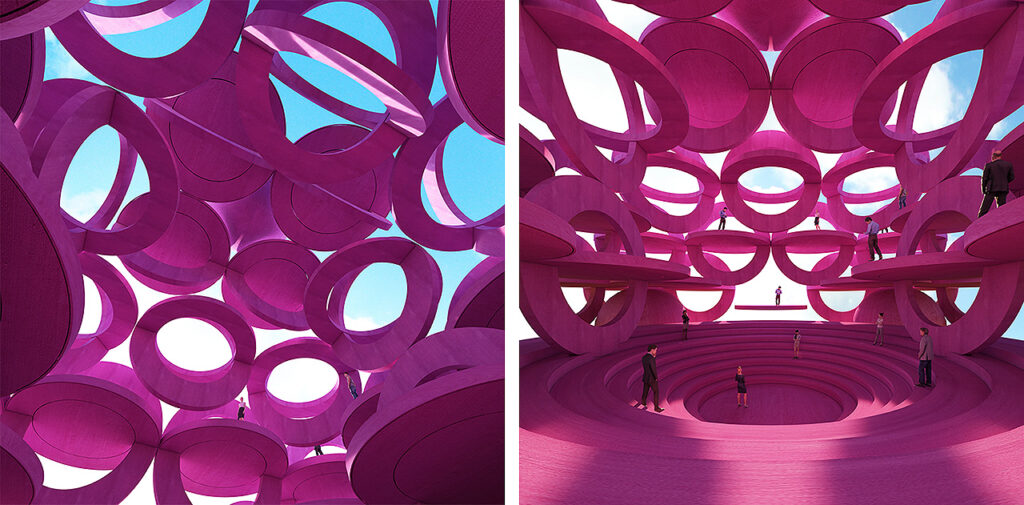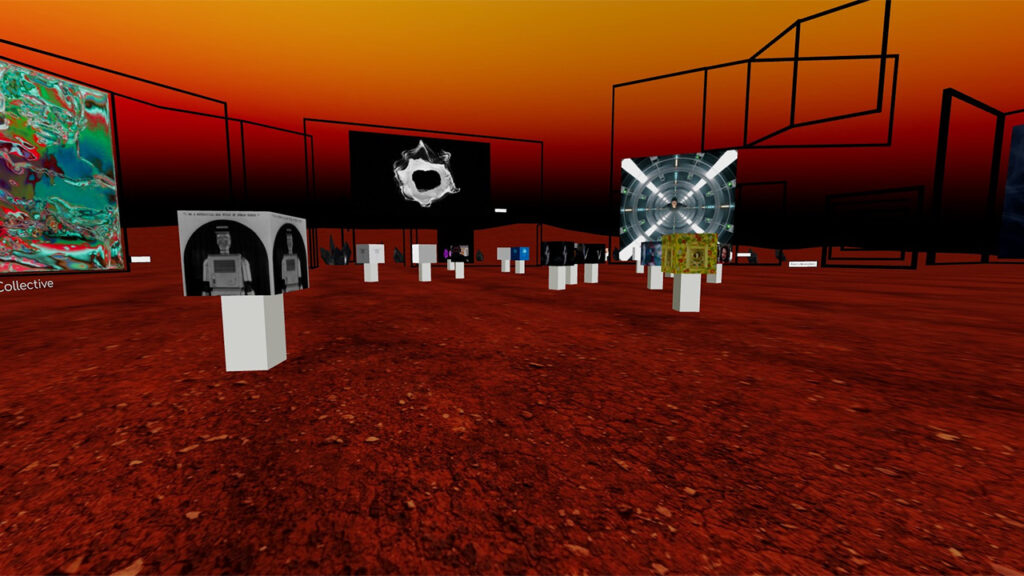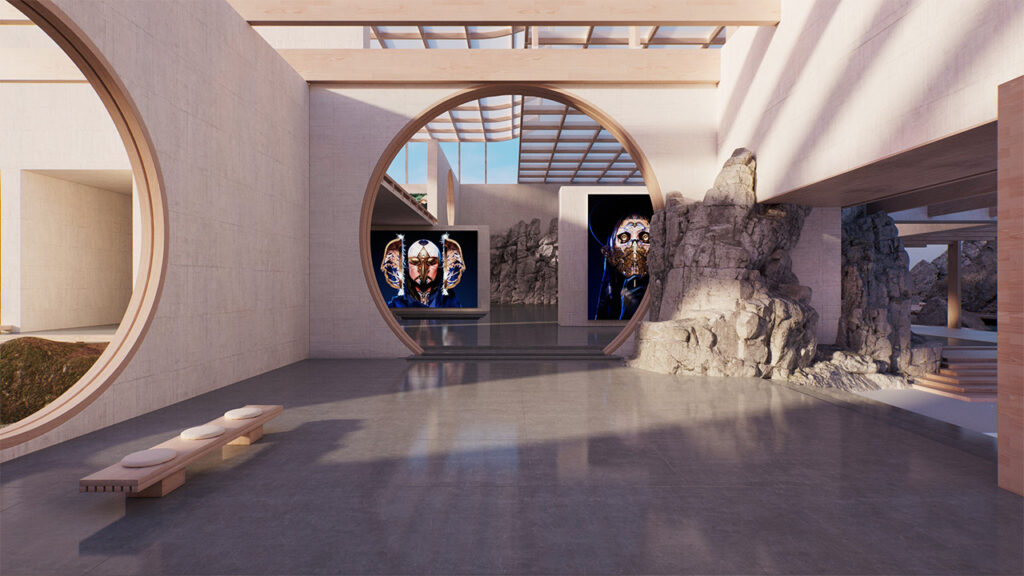It’s fitting that the metaverse environment Benny Or co-founded, along with with his partner Cristian Andres and artist Cyril Lancelin, should be dubbed The Meeting Place. For him, the virtual realm is as much a space to build as it is a place to gather. “Architecture devoid of human life is like a painting without a viewer,” the artist tells Jing Culture & Commerce. “What started for us as a creative investigation into metaverse architecture became a place with a purpose when we began to involve a community.”
As it continues to scale, The Meeting Place on Spatial has become a versatile space within which to host virtual events (including our April webinar), in addition to being “one of the top safe spaces in the metaverse for the LGBTQIA+ community,” says Or. It’s the kind of impact — making art accessible, making the digital personal — that he’s sought throughout his practice, whether he’s developing touring productions for the likes of Billie Eilish or in his latest role as Creative Director of [0], the metaverse company established by Krista Kim.

Launched last year, The Meeting Place has become a versatile social environment and “one of the top safe spaces in the metaverse for the LGBTQIA+ community,” according to Or. Images: The Meeting Place / Cyril Lancelin
With the metaverse gaining steam within the cultural sector and projected to reach $5 trillion in value by 2030, such a community-centered approach to virtual architecting is bound to be critical. And particularly so if Web3 is to evolve virtual experiences and storytelling, enabling individuals to more deeply direct and personalize their online and on-chain interactions. The metaverse needs a human hand to make it, well, human. “A good experience in the metaverse is akin to stumbling upon a great work of art or architecture,” emphasizes Or. “The technical aspects fall into the background, and you are alive. You feel it in your bones.”
Here’s more from Or on how he approaches building in and for the metaverse.
How do you see the metaverse’s potential for the art and culture sectors?
I see the metaverse as an opportunity for creators, artists, and institutions to rethink how they tell stories, share information, and communicate with their audience. Powerful storytelling has always been a cornerstone of arts and culture. This new immersive frontier will allow us to connect with people in a more affective and accessible way, one that is more representative of the intricacies of our physical reality.

The VCA Residency Auction by VerticalCrypto Art on Arium Space. Image: @AriumSpaces on Twitter
And what do you make of how art and cultural organizations have built in the virtual environment?
Most art and cultural organizations are currently still dipping their toes in the water. Instead, I’ve seen a lot of private collectors and grassroots organizations take charge of finding utility in the metaverse. For example, I recently attended a virtual event hosted by VerticalCrypto Art in Arium Space, where hundreds of people worldwide could log into a custom-designed environment to promote an auction while celebrating the ending of the organization’s art residency. Meanwhile, despite it not being a social experience or accessible through VR, NFT collector Art on Internet’s virtual museum Shōyu is one of the best visual examples of a virtual gallery I’ve seen so far.
How do you approach building or architecting in the metaverse?
Building in the metaverse requires one to be honest with one’s senses. Virtual architecture alleviates designers from the pragmatism of the physical realms, but it also challenges us to confront and define the essentials of experience. Architects will need to start thinking more like sculptors. Variables like scale, texture, lighting, and time become critical ingredients to a believable and moving metaverse.

The Shōyu metaverse gallery by Art on Internet — “one of the best visual examples of a virtual gallery I’ve seen so far,” says Or. Image: @SHOYU_NFT on Twitter
Concretely, what does it take to build a metaverse experience in terms of tech expertise, resources, and processes?
The process is actually very similar to building an exhibition in the physical world, and finding the right partnerships will be key to your success regardless of your metaverse goals.
Think of it in three parts: design, integration, and activation. The first step is to work with a 3D designer or studio to define the environment and experience. The following step would be then to integrate the model into your metaverse of choice. Similar to the construction phase of a real-world project, this process will require the most technical expertise and support. Lastly, you need to activate the experience, which involves traditional marketing, user education, and event planning capabilities.
What are some pitfalls that might come with building in the metaverse, and how should they be addressed or avoided?
A question I always ask myself when seeing art in the metaverse is whether or not the environment enhances or diminishes my experience of the work, and usually, it is the latter. You should always consider the artwork first when exhibiting in virtual worlds. By doing so, the environments effectively become extensions of the work itself, and the viewer becomes part of the experience.
Finally, what future or yet-untapped opportunities do you see in the virtual space?
With the metaverse, we are witnessing the expansion of the human definition of reality. And with it comes new ways of seeing, feeling, and living. With high fidelity, real-time rendering of photorealistic environments and avatars on its way, our digital lives will eventually feel just as natural as our physical ones. Personally, I’m interested in the narrative potential of the metaverse. Similar to the emergence of the modern music video in the 1980s, I believe we are about to witness a new genre of digital entertainment, and I’m excited to be a part of its creation.



